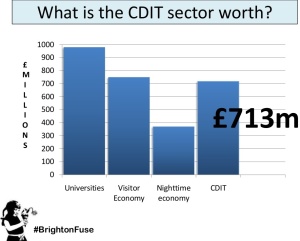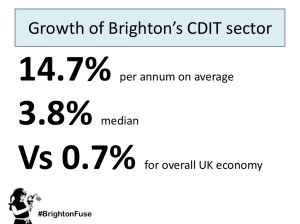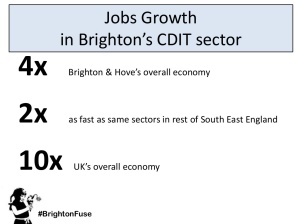Recent weeks in Brighton have seen the rise of an odd coalition of big business and trades unions – strange bedfellows coming together to release the motorist from perceived chains of bondage. Aspirations of the group centre upon reduction or elimination of parking charges, increase of the space available for driving and parking, removal of restriction from bus lanes, and opposition to reduction of speed limits.
Our coalition for the car feels that these outcomes are of vital importance to the economy of our city because they are responding to the needs of businesses. While some parts of our local economy retain significant dependence on car use, this is really only part of the picture.
Brighton Fuse is a 2-year research and development project looking to map, measure and assist Brighton’s creative, digital and IT (CDIT) cluster.
“Brighton Fuse believes that when those operating in the creative sector and the digital and technology industries connect they spark new ideas and light the fuse of innovation. The result can be effective and sustainable economic growth and the fusion of a stronger creative culture nurturing and supporting further innovation and development.”
In a recent presentation, Phil Jones of Wired Sussex (one of the partners in the Fuse project) gave an indication of the value of the CDIT cluster to the economy of the city – from the graph below we can see that it has become a significant player – almost level with the visitor economy in value.
The importance of this sector to our city is further underlined by its impressive growth:
In the report The Brighton Fuse they attempt to describe the sector – who is involved, what sort of things which are produced and, crucially, what the features are of the sector and of the city which make it such a good fit here and help it to thrive.
Though of course not the only factor, the themes which come up again and again in the report are about the ease of life in a compact city – a good rail link with London and Gatwick is significant, but much is made about the liveability and walkability of the place, and the ease of sustaining networks based around a variety of venues within easy walking reach of each other – as one contributor to the report notes: “I liked the idea of being able to walk to work, a short ride to work, and the work-life balance was really up there”
The Wired Sussex website includes listings of workspaces for the sector. Of all those currently advertised nearly all talk of location in terms of ease of walkability, proximity to the train station, city centre and beach. Not a single workspace for rent mentions parking or car access in any way. It is possible that our most nimble businesses are also our most pedestrian.
Rather than driving us blindly down the road of the car, it is worth spending time looking at what is ‘really’ happening in our city and economy. The CDIT sector is just one example of the way that good public transport and infrastructure aimed at those outside the car is responding to the needs of the future and bringing dividends in terms of investment and growth.


